class: center, middle .title[Emissions and Plume Models] <br> .subtitle[BEE 4750/5750] <br> .subtitle[Environmental Systems Analysis, Fall 2022] <hr> .author[Vivek Srikrishnan] <br> .date[October 24, 2022] --- name: toc class: left # Outline <hr> 1. Homework 4 Release 2. Questions? 3. Emissions of Pollutants 4. Gaussian Plume Models of Point Source/Receptors --- name: poll-answer layout: true class: left # Poll <hr> .left-column[{{content}} URL: [https://pollev.com/vsrikrish](https://pollev.com/vsrikrish) Text: **VSRIKRISH** to 22333, then message] .right-column[.center[]] --- name: questions template: poll-answer ***Any questions?*** --- layout: false # Last Class <hr> * Unit Commitment * Increased Complexity Switching from LP to MIP --- class: left # Air Pollution <hr> .center[ .cite[Source: [Utah Department of Environmental Quality](https://deq.utah.gov/communication/news/ask-an-environmental-scientist-what-air-pollutants-does-deq-test-for)]] --- class: left # Greenhouse Gases <hr> .center[ .cite[Source: [NRDC](https://www.nrdc.org/stories/greenhouse-effect-101)]] --- class: left # Clean Air Act Impacts <hr> .center[ .cite[Source: [Resources for the Future](https://www.rff.org/news/press-releases/clean-air-act-successes-and-challenges-1970/)]] --- class: left # Modeling Air Pollution <hr> There are many approaches to modeling concentrations of pollutants/chemicals, including: 1. Point sources/receptors (plume/puff models) 2. Analyzing an "airshed" (box models) --- class: left # Point Sources/Receptors <hr> In this case, we're concerned about the dispersal from a point source: .center[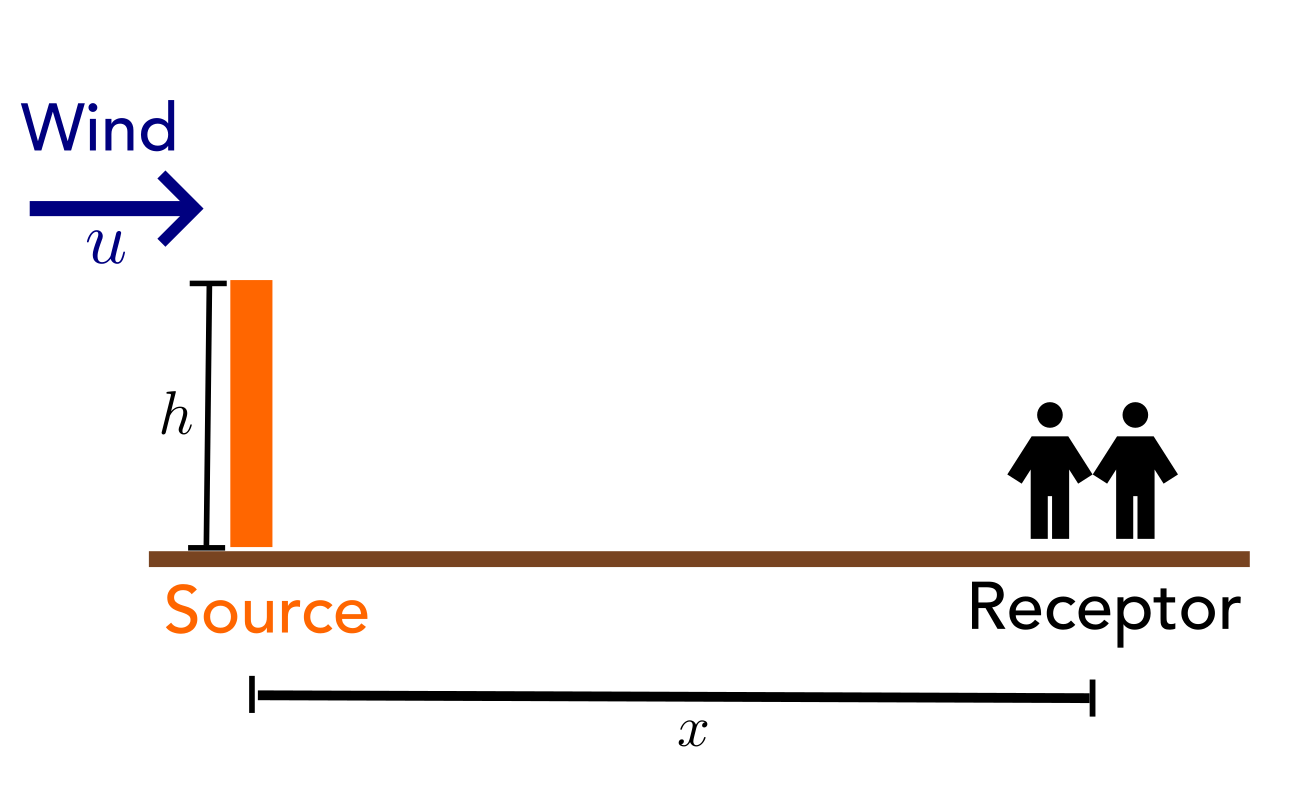] --- # Point Sources/Receptors <hr> At a given instant, the flow from source to receptor follows some path: .center[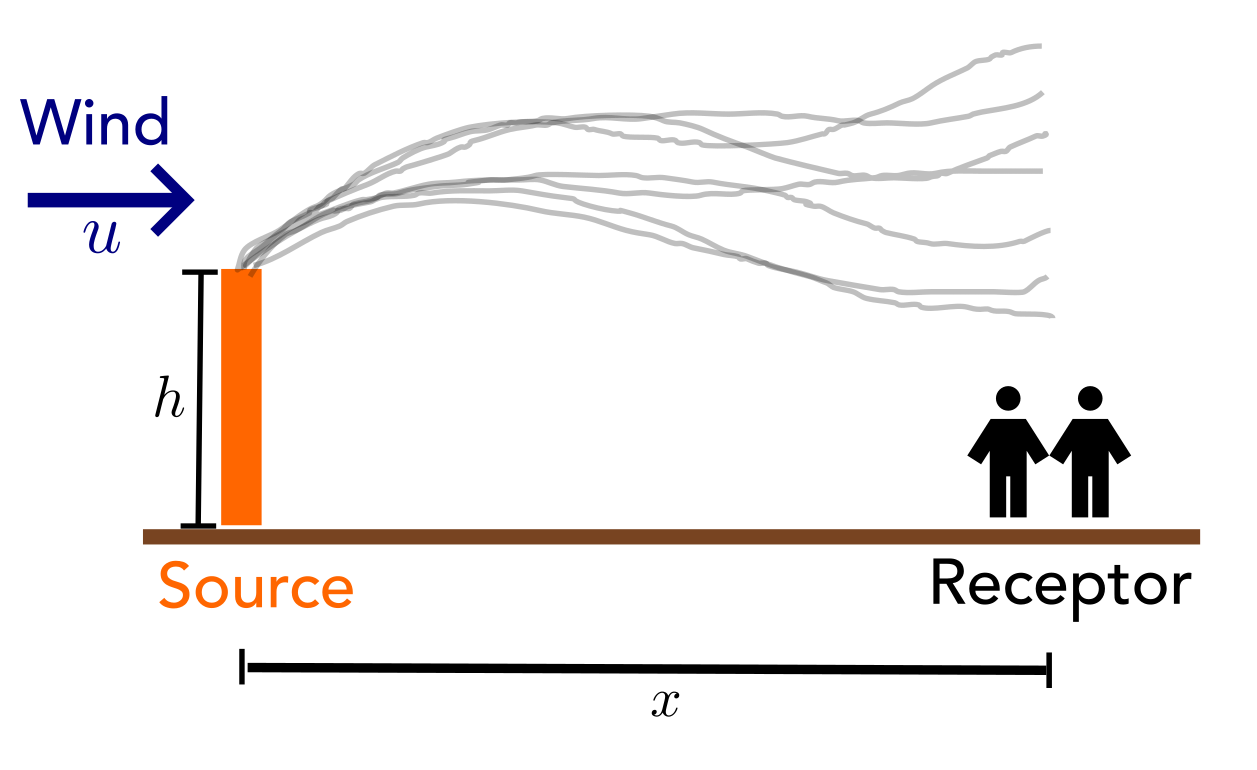] --- # Point Sources/Receptors <hr> Averaging over time gives us a "plume": .center[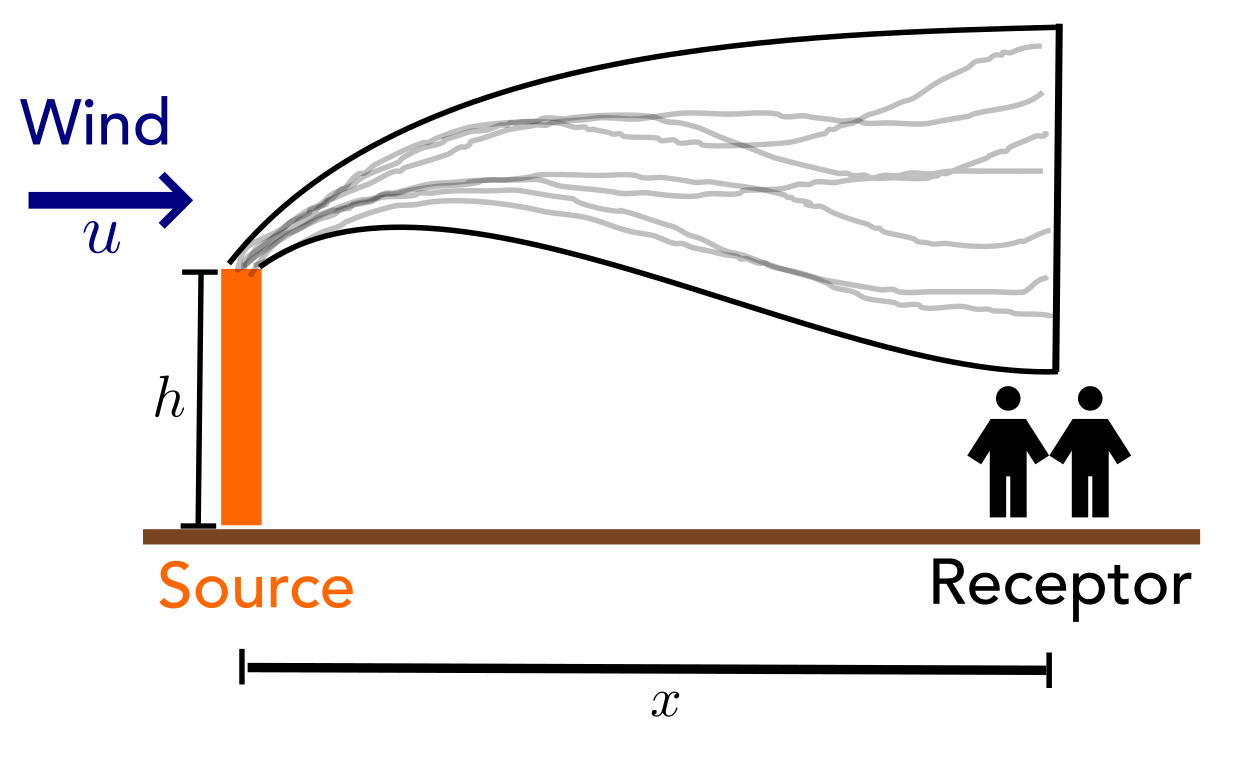] --- # Point Source/Receptors <hr> What is the distribution of pollutant above the receptor? .center[] --- # "Gaussian Plume" <hr> We can reason that the concentration follows a "bell curve": .center[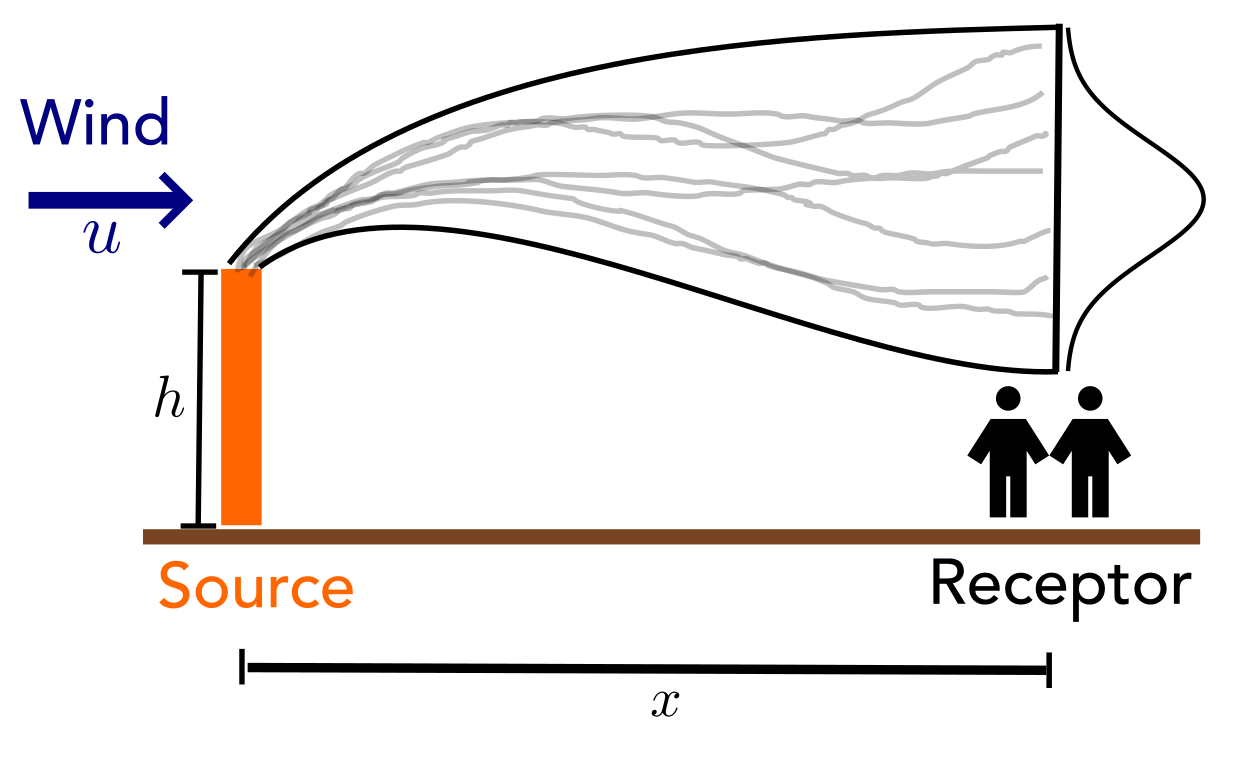] --- # "Gaussian Plume" <hr> We can reason that the concentration follows a "bell curve": .center[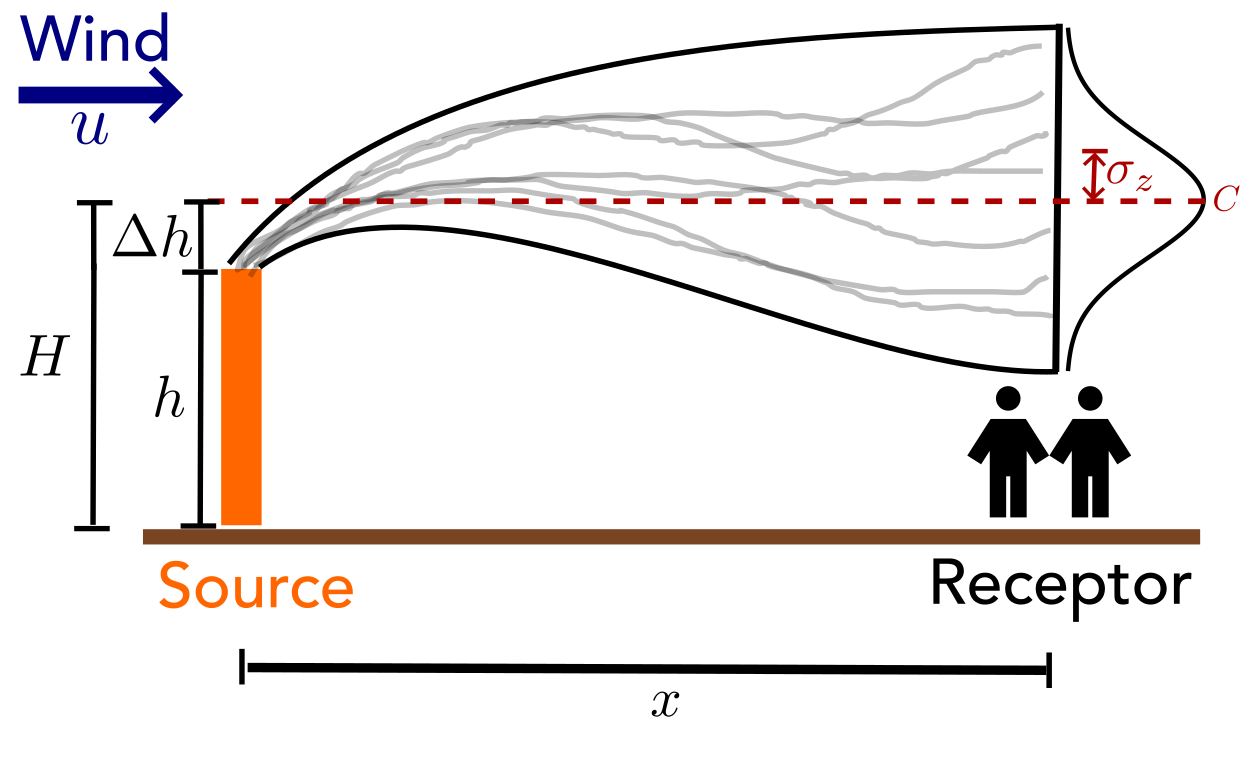] --- # "Gaussian Plume" <hr> Not illustrated here, but this same reasoning applies cross-wind. .center[] --- # Gaussian Plume Model <hr> For an elevated source **without reflection**: $$ C(x,y,z) = \frac{Q}{2\pi u\sigma_y \sigma_z} \exp\left[-\frac{1}{2}\left(\frac{y^2}{\sigma_y^2} + \frac{(z - H)^2}{\sigma_z^2}\right)\right]. $$ | Variable | Meaning | |:---------:|:------------------------------------------- | | $C$ | Concentration (g/m$^3$) | | $Q$ | Emissions rate (g/s) | | $u$ | Wind speed (m/s) | | $H$ | Height of source (m) | | $x, y, z$ | Downwind, crosswind, vertical distances (m) | --- # Gaussian Plume Model Derivation <hr> We use the **advective-diffusion equation** to describe the mass-balance: $$ \frac{\partial C}{\partial t} = [D + K] \nabla^2 C - \vec{u} \cdot \vec{\nabla} C $$ where $D$ is the diffusion coefficient, $K$ is the dispersion coefficient due to turbulent mixing. --- # Diffusive Flux <hr> .left-column[.center[]] .right-column[.middle[ Fick's law: mass transfer by diffusion $$F_x = D\frac{dC}{dx} Concentration gradient + diffusion $\Rightarrow$ Flux]] --- # Turbulent Flux <hr> .left-column[.center[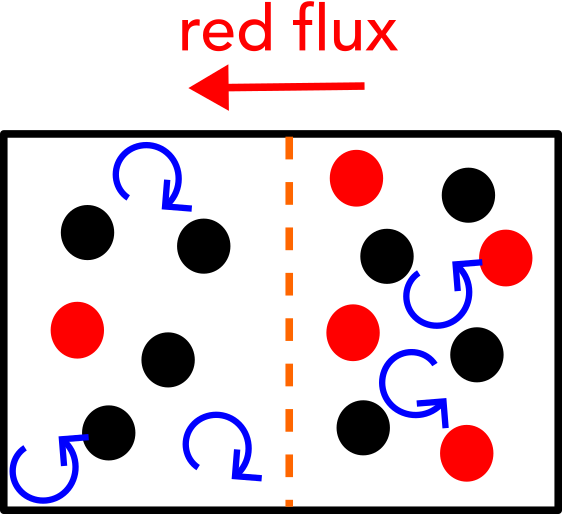]] .right-column[.middle[ $$F\_x = K\_{xx} \frac{dC}{dx} $$ The dispersion coefficient $K_{xx}$ depends on flow/eddy characteristics. Concentration gradient + turbulent mixing $\Rightarrow$ Flux]] --- # Gaussian Plume Model Derivation <hr> $$ \frac{\partial C}{\partial t} + \vec{u} \cdot \vec{\nabla} C - [D + K] \nabla^2 C = 0 $$ Assumptions: -- * Steady-state, e.g. $\frac{\partial C}{\partial t} = 0$ --- # Gaussian Plume Model Derivation <hr> $$ \frac{\partial C}{\partial t} + \vec{u} \cdot \vec{\nabla} C - [D + K] \nabla^2 C = 0 $$ Assumptions: * Wind only in the $x$-direction: $$ \vec{u} \cdot \vec{\nabla} C = u_x \frac{\partial C}{\partial x} + \cancel{u_y \frac{\partial C}{\partial y}} + \cancel{u_z \frac{\partial C}{\partial z}} $$ --- # Gaussian Plume Model Derivation <hr> $$ \frac{\partial C}{\partial t} + \vec{u} \cdot \vec{\nabla} C - [D + K] \nabla^2 C = 0 $$ Assumptions: * Turbulence $>>$ diffusion, e.g. $K >> D$, and $K$ is unimportant along $x$-direction: $$ -[\cancel{D} + K] \nabla^2 C = \cancel{K\_{xx}} \frac{\partial^2 C}{\partial x^2} + K\_{yy} \frac{\partial^2 C}{\partial y^2} + K\_{zz} \frac{\partial^2 C}{\partial z^2} $$ --- # Gaussian Plume Model Derivation <hr> With these assumptions, the equation simplifies to: $$ u \frac{\partial C}{\partial x} = K\_{yy} \frac{\partial^2 C}{\partial y^2} + K\_{zz}\frac{\partial^2 C}{\partial z^2} $$ -- .left-column[ Assume mass flow through vertical plane downwind must equal emissions rate $Q$: $$ Q = \iint u C dy dz $$ ] .right-column[ .center[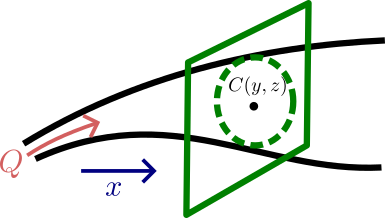] ] --- # Gaussian Plume Model Derivation <hr> Solving this PDE: $$ C(x,y,z) = \frac{Q}{4\pi x \sqrt{K\_{yy} + K\_{zz}}} \exp\left[-\frac{u}{4x}\left(\frac{y^2}{K\_{yy}} + \frac{(z-H)^2}{K\_{zz}}\right)\right] $$ -- To deal with $K$, substitute: $$ \begin{aligned} \sigma\_y^2 &= 2 K\_{yy} t = 2 K\_{yy} \frac{x}{u} \\\\ \sigma\_z^2 &= 2 K\_{zz} \frac{x}{u} \end{aligned} $$ --- # Gaussian Plume Model Derivation <hr> Solving this PDE: $$ \begin{aligned} C(x,y,z) &= \frac{Q}{4\pi x \sqrt{K\_{yy} + K\_{zz}}} \exp\left[-\frac{u}{4x}\left(\frac{y^2}{K\_{yy}} + \frac{(z-H)^2}{K\_{zz}}\right)\right] \\\\ \Rightarrow C(x,y,z) &= \frac{Q}{2\pi u \sigma\_y \sigma\_z} \exp\left[-\frac{1}{2}\left(\frac{y^2}{\sigma\_y^2} + \frac{(z-H)^2}{\sigma\_z^2}\right) \right], \end{aligned} $$ which looks like a Gaussian distribution probability distribution if we restrict to $y$ or $z$. --- # Gaussian Plume Model with Reflection <hr> Last piece: the ground dampens vertical dispersion. .left-column[.center[]] .right-column[The mass that would be dispersed below the ground is reflected back, increasing the concentration.] --- # Gaussian Plume Model with Reflection <hr> .left-column[We can account for this extra term using a flipped "image" of the source.] .right-column[.center[]] --- # Final Model: Elevated Source with Reflection <hr> $$ \begin{aligned} C(x,y,z) = &\frac{Q}{2\pi u \sigma\_y \sigma\_z} \exp\left(\frac{-y^2}{2\sigma\_y^2} \right) \times \\\\ & \quad \left[\exp\left(\frac{-(z-H)^2}{2\sigma\_z^2}\right) + \exp\left(\frac{-(z+H)^2}{2\sigma\_z^2}\right) \right] \end{aligned} $$ --- # Final Model: Elevated Source with Reflection <hr> Assumptions: 1. Steady-State 2. Constant wind velocity and direction 3. Wind >> dispersion in $x$-direction 4. No reactions 5. Smooth ground (avoids turbulent eddies and other reflections) --- # Gaussian Plume Example <hr> SO$_2$ is emitted at a rate of $100 \text{g/s}$ from the top of a $100 \text{m}$-high chimney. The plume initially rises $10 \text{m}$ before being convected horizontally by a wind speed of $15 \text{m/s}$. What is the centerline ground-level concentration $3 \text{km}$ downwind if at this distance $\sigma_y = 80 \text{m}$ and $\sigma_z=30 \text{m}$ under current meteorological conditions? $$ \begin{aligned} C(x,y,z) = &\frac{Q}{2\pi u \sigma\_y \sigma\_z} \exp\left(\frac{-y^2}{2\sigma\_y^2} \right) \times \\\\ & \quad \left[\exp\left(\frac{-(z-H)^2}{2\sigma\_z^2}\right) + \exp\left(\frac{-(z+H)^2}{2\sigma\_z^2}\right) \right] \end{aligned} $$ --- # Gaussian Plume Example <hr> SO$_2$ is emitted at a rate of $100 \text{g/s}$ from the top of a $100 \text{m}$-high chimney. The plume initially rises $10 \text{m}$ before being convected horizontally by a wind speed of $15 \text{m/s}$. What is the centerline ground-level concentration $3 \text{km}$ downwind if at this distance $\sigma_y = 80 \text{m}$ and $\sigma_z=30 \text{m}$ under current meteorological conditions? | Variable | Value | |:---------:|:----- | | $Q$ | ? | | $u$ | ? | | $H$ | ? | | $x, y, z$ | ? | --- # Gaussian Plume Example <hr> SO$_2$ is emitted at a rate of $100 \text{g/s}$ from the top of a $100 \text{m}$-high chimney. The plume initially rises $10 \text{m}$ before being convected horizontally by a wind speed of $15 \text{m/s}$. What is the centerline ground-level concentration $3 \text{km}$ downwind if at this distance $\sigma_y = 80 \text{m}$ and $\sigma_z=30 \text{m}$ under current meteorological conditions? | Variable | Value | |:---------:|:-------------- | | $Q$ | 40 (g/s) | | $u$ | 2 (m/s) | | $H$ | 110 (m) | | $x, y, z$ | 3000, 0, 0 (m) | --- # Gaussian Plume Example <hr> SO$_2$ is emitted at a rate of $100 \text{g/s}$ from the top of a $100 \text{m}$-high chimney. The plume initially rises $10 \text{m}$ before being convected horizontally by a wind speed of $15 \text{m/s}$. What is the centerline ground-level concentration $3 \text{km}$ downwind if at this distance $\sigma_y = 80 \text{m}$ and $\sigma_z=30 \text{m}$ under current meteorological conditions? $$ \begin{aligned} C(3000,0,0) = &\frac{100 \text{g/s}}{2\pi (15 \text{m/s})(80 \text{m})(30 \text{m})} \exp(0) \times \\\\ & \quad \left[\exp\left(\frac{-(-110 \text{m})^2}{2(30 \text{m})^2}\right) + \exp\left(\frac{-(110 \text{m})^2}{2(30 \text{m})^2}\right) \right] \end{aligned} $$ --- # Gaussian Plume Example <hr> SO$_2$ is emitted at a rate of $100 \text{g/s}$ from the top of a $100 \text{m}$-high chimney. The plume initially rises $10 \text{m}$ before being convected horizontally by a wind speed of $15 \text{m/s}$. What is the centerline ground-level concentration $3 \text{km}$ downwind if at this distance $\sigma_y = 80 \text{m}$ and $\sigma_z=30 \text{m}$ under current meteorological conditions? $$ C(x,y,z) = .27 \text{mg/m}^3, $$ which is around 2% of the [NIOSH short-term exposure standard for SO$_2$](https://www.cdc.gov/niosh/npg/npgd0575.html). --- # Estimating Dispersion "Spread" <hr> Values of $\sigma_y$ and $\sigma_z$ matter substantially for modeling plume spread downwind. What influences them? --- # Estimating Dispersion "Spread" <hr> **Main contribution**: atmospheric stability Pasquill (1961): Six stability classes, A -> F. --- # Estimating Dispersion "Spread" <hr> Contributors to atmospheric stability: * Temperature gradient * Wind speed * Solar radiation * Cloud cover * Richardson number (buoyancy / flow shear) --- # Estimating Dispersion "Spread" <hr> Can estimate deviations based on stability class, $$ \begin{aligned} \sigma_y &= ax^b \\\\ \sigma_z &= cx^d + f \end{aligned} $$ where the coefficients are linked to the stability class. --- # Multiple Point Sources <hr> .left-column[ Suppose we have three sources of SO$_2$: | Source | Emissions (kg/day) | Effective Height (m) | Removal Cost ($/kg) | |:------:| ------------------:| --------------------:| -------------------:| | 1 | 34,560 | 50 | 0.20 | | 2 | 172,800 | 200 | 0.45 | | 3 | 103,680 | 30 | 0.60 | and five receptors with $u = 1.5$ m/s and air quality standard 150 $ \mu$g/m$^3$. ] /private/var/folders/24/8k48jl6d249_n_qfxwsl6xvm0000gn/T/jl_BQWGUc/build/multiple-sources.svg .right-column[.center[]] --- # Key Takeaways <hr> * Regulatory controls (or lack thereof) on air pollutants (Clean Air Act, etc) and greenhouse gas emissions (patchwork) * Concentrations of contaminants can be modeled in several ways, depending on the goal and assumptions. * Point source/receptor: Gaussian plume is common approach. --- class: center, middle <hr> # Next Class <hr> * Multiple source example * Box models of airsheds